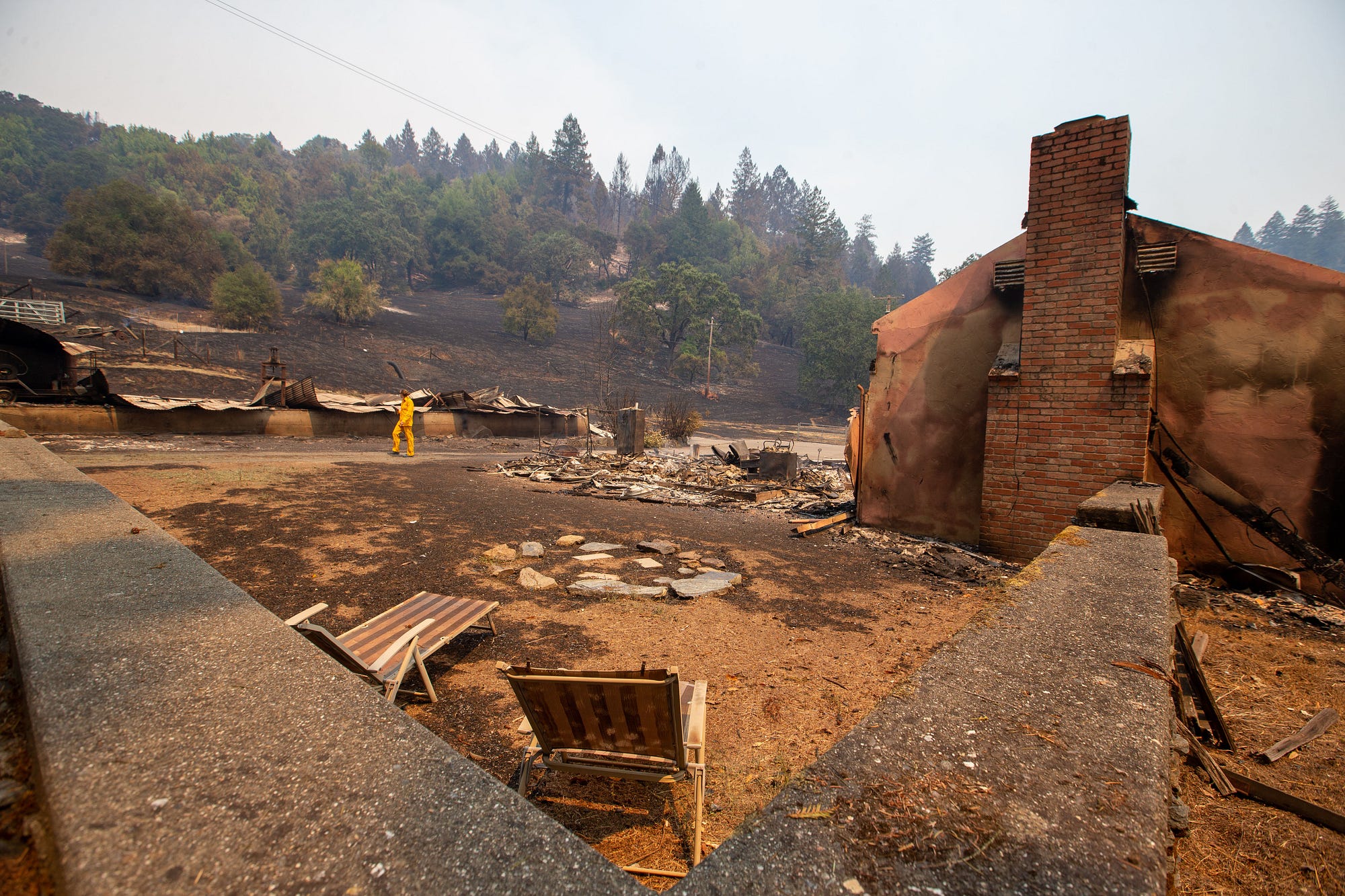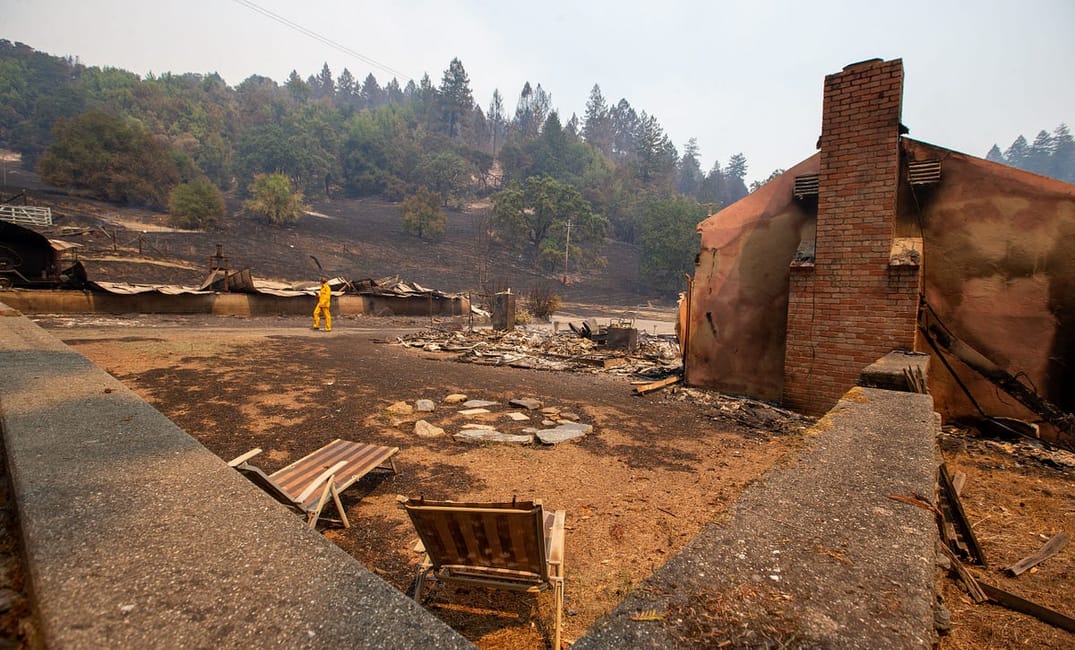The Californian’s Dilemma

This week in The Bold Italic, we are publishing A Californian’s Dilemma, a series that goes beyond the headlines about the “California Exodus,” featuring essays from San Franciscans about why they’re choosing to stay or leave. Check back daily for new articles.
As I write this, the Golden State is living up to its name — the world here looks golden. A hazy, apocalyptic, never-ending sunset. Our bags are packed, and we’re holding our breath, awaiting that evacuation notice. With every breath, I taste smoke. I’ve had a searing headache for a week, and my eyes feel like they’re burning.
This is not normal. Or, at least, it shouldn’t be. Right? Now, I wonder. Why do I live here? Is my job worth this stress, potentially losing everything I own, and whatever health effects this air is doing?
I don’t know if I can keep doing this. Is this normal? Could this get worse? Is California a livable state anymore?
Sign up for The Bold Italic newsletter to get the best of the Bay Area in your inbox every week.
These questions have wracked my brain, and likely yours if you also live in this state. I decided to delve into the research.
It’s no surprise California ranks as the most disaster-prone state: mudslides, earthquakes, wildfires, winter storms, droughts — we have it all. Granted, these seem like one-off events that don’t affect the typical Californian. But when they do occur, these disasters have a direct impact on the state’s livability, from the air we breathe, to where we can have homes, to when we can be outside, to how much life we live.
As a state, we’re running out of land, electricity, housing, water, and road space. Our quick fixes of building further out and sprawling, diverting water from rivers, and just adding lanes to our highways have all backfired.
If you’re also figuring out the livability of California in the coming years, here’s a look at where we stand.
Wildfires
Before this year, the record for most acres burned in a year in California belonged to 2018 at 1.975 million acres, with a five-year average of only 346,045 acres burned. But without a doubt, this record for most acres burned now goes to 2020. As of September 27, we’ve already seen 3.7 million acres burned since the beginning of the year.
Meager rains leading to an arid landscape, combined with a rainless lightning storm, tossed in with a lethal fire tornado, and some idiots with a gender reveal party pyrotechnics device have made for a fire season not to be forgotten. And yet, we still have the most dangerous months of the fire season ahead of us; the Diablo and Santa Ana winds have only just begun. Experts predict these megafires will become routine and even more intense — this year is no fluke.
Extreme heat and droughts
On August 16, 2020, Death Valley recorded the likely highest ever reliably recorded temperature reading on Earth at 130°F (54.4°C). A few weeks later, on September 6, Los Angeles set a new county record of 121°F. Luckily my neighborhood was a few degrees cooler, at a balmy 117°F. Meanwhile, in San Francisco, the city’s sensors exceeded 100°F for the first time in a few years — since setting a record for the city of 106°F on September 2, 2017.
I wish these were simply anomalies, but this is the new normal. According to NASA, this fits the trend of heat waves becoming more intense, more frequent, and longer, while their season is widening to start earlier and persist later in the year.
With heatwaves come an increase in deaths and complications from direct conditions like heat stroke and dehydration and risk from chronic illnesses such as cardiovascular disease, diabetes, and kidney disease. As heat waves worsen, so do the associated health impacts; from 2005 to 2015, Los Angeles saw a 35% increase in heat-related emergency room visits. In the United States, heat causes the most weather-related deaths.
In California, droughts and heatwaves bring scorching temperatures and dry conditions, which fuel the state’s wildfires, increase water demand, worsen air quality, and put strain on the power grid. A Stanford-led study found that due to climate change, autumn days with extreme fire weather have more than doubled since the 1980s due to an increase in temperature (~2°F) and a decrease in autumn precipitation (~30%).
Air quality
The smoggy state. California is home to eight of the ten most polluted cities in the United States. The 2018 Camp Fire in Paradise produced the longest-running streak of unhealthy air quality on record in the Bay Area at 14 days, but 2020 recently crushed that record, with 30 consecutive Spare the Air red alert days.
The most common air pollutants are particulate matter, ozone, nitrogen dioxide, carbon monoxide, and sulfur dioxide. Los Angeles, where I currently call home, is the nation’s most ozone-polluted city. The top five cities in the U.S. with the worst particulate matter that is 2.5 microns in size or less, or PM2.5, are all in California and include both the Bay Area and Los Angeles.
We can compare breathing polluted air to smoking cigarettes. The recommended safe limit for PM2.5 is 10μg/m³, according to the World Health Organization. Breathing air with 22 μg/m³ for one day is like smoking a cigarette.
- The U.S.’s air, on average, is equivalent to smoking 0.4 cigarettes per day.
- The Bay Area, on average, is equivalent to smoking 2.1 cigarettes per day.
- In the past month, due to wildfires, my neighborhood’s air quality has been the equivalent of around 19 cigarettes per day, while many Californians were seeing eight–23 cigarettes per day in their outdoor air quality.
Breathing in poor air quality is a significant cause of death and disease globally, according to the World Health Organization, as it increases the risk for lung cancer, stroke, acute lower respiratory infection, heart disease, and chronic obstructive pulmonary disease. The state’s wildfires only exacerbate these issues, adding more ozone, carbon monoxide, polycyclic aromatic compounds, nitrogen dioxide, and particulate matter into our atmosphere.
Sea level rising
Since 1900, San Francisco has seen a mean sea level increase of seven inches. This trend is consistent down the California coast and across the world, and is only forecasted to worsen with time. Less than four feet above current high tide lies fragile ecosystems, coastal communities, hundreds of thousands of homes, and both the San Francisco and Oakland airports. To learn how this might impact your community, check out NOAA’s interactive map here.
Two-thirds of Southern California’s beaches will likely disappear by 2100 without large-scale human intervention. This will threaten coastal communities, demand expensive infrastructure upgrades, diminish fragile coastal wetland ecosystems, and increase the risk of flooding and coastal erosion.
Unaffordable housing
Amidst the conversations of disappearing beaches, impending and active disasters, and the threats that climate change poses to our communities, we need to talk about the economic feasibility for people to live here and deal with these challenges.
The more affordable housing is on the fringes of urban areas, and the most likely to encounter a wildfire or be swept up by a mudslide. Buying a home and renting continues to be significantly more expensive than many can afford.
According to Zillow, California’s Home Value Index is $578,267, which is 2.32 times higher than the national average of $248,857. Similarly, the median rent in California is $2,775, which tracks in as 1.68 times higher than the national average of $1,650. While Californians tend to make more, with a median household income of $75,277, this is only 1.22 times higher than the national figure at $61,936.
I just want a breath of fresh air. Literally. I’m tired of tasting smoke and this everlasting headache. But it’s more than that. I’m tired of not being able to afford to live here (even as an engineer!), being afraid of what the environment is doing to my health, and not being able to believe in a sustainable future for the state I am living in. At least, in its current condition.
Plagued by extreme weather, unpredictable disaster events, sprawl, and economic inequalities, the situation looks grim. And it’ll get worse before it gets better.
The predicted (and current) future here looks apocalyptic. The global climate crisis is the most significant threat to California’s livability since it contributes to the wildfires, extreme heat and droughts, air quality, and rising sea levels. Unless we take action, California is hurtling toward an unlivable future.
So, what can we do? Well, the effects of climate change can be mitigated in California and across the world. But we have a lot of work to do. Our local and federal governments need to work together to combat climate change and advance the sustainability of our species through prevention and systematic changes.
But for now, it’s California as we know it. And I don’t feel fine. Our evacuation warning persists as the wildfire rages on. It’s only 3% contained, moving toward us in the foothills, and expected to burn for another month and a half. So my bags remain packed and by the door, and I’m confined indoors due to the hazardous air.
Seeing this climate change crisis unfold in my backyard, I realize that we don’t just need to take action on behalf of our children and grandchildren, but for our own generation, too. So, as I carry my air purifier from room to room with me, I’m plotting my move out-of-state, to greener pastures and starting on my next research question: What specific actions and measures can I take in my life to be more sustainable and resilient, and how can I help my community in these efforts?
Resources
- Learn how to improve your indoor air quality during wildfires
- Learn more about specific climate change impacts on California: Office of Environmental Health Hazard Assessment, California Environmental Protection Agency (2018). Indicators of Climate Change in California.
- Learn about your carbon footprint: Nature Conservancy Calculator.
- Learn about day-to-day sustainable choices you can make: “How to Reduce Your Carbon Footprint.”
- Learn how little things can make a big difference: “101 Ways to Live Sustainably.”
- Learn about a blueprint for achieving a better and more sustainable future for all: United Nations Sustainable Development Goals.
- Learn about ways to get involved with helping California’s environment: organizations with volunteer opportunities.







